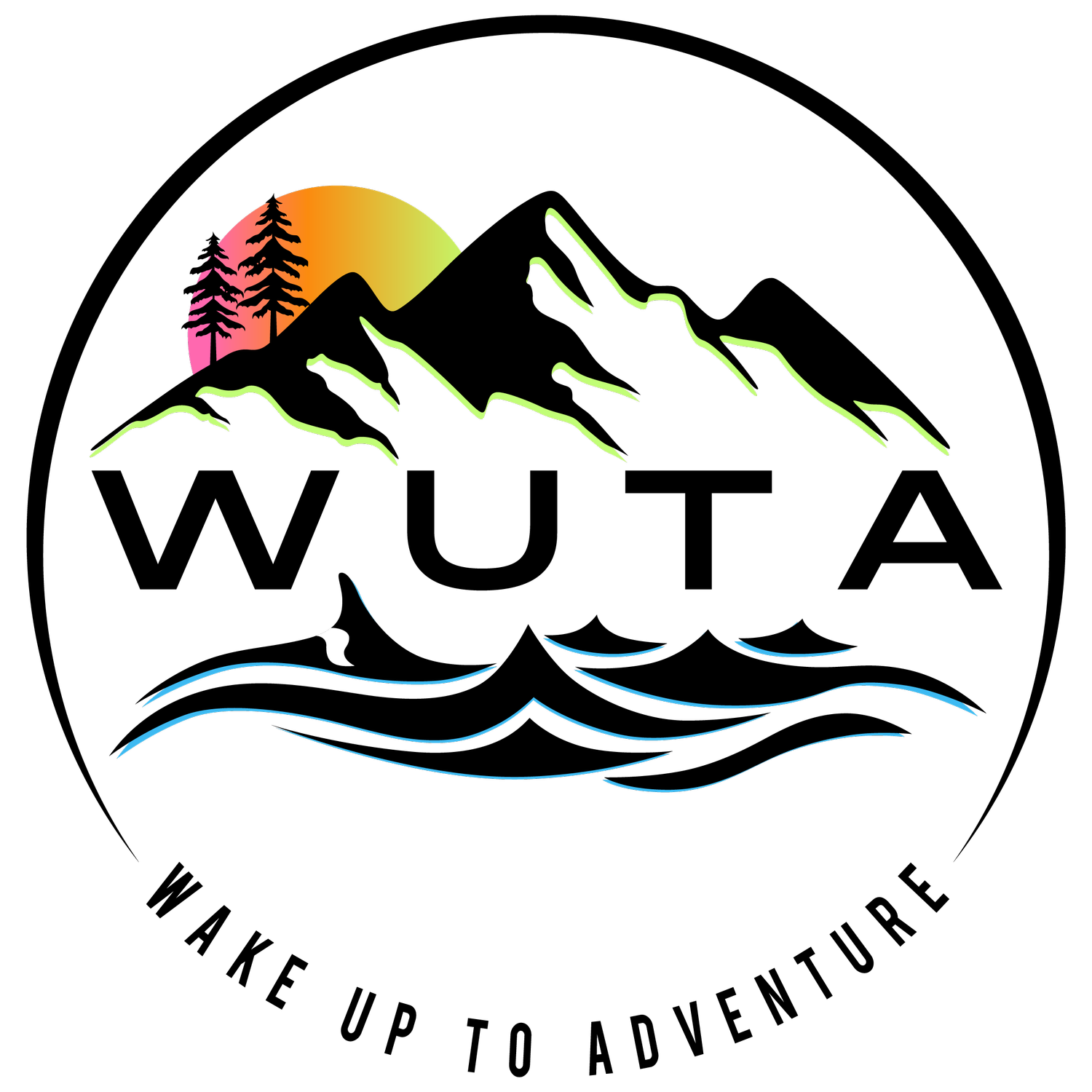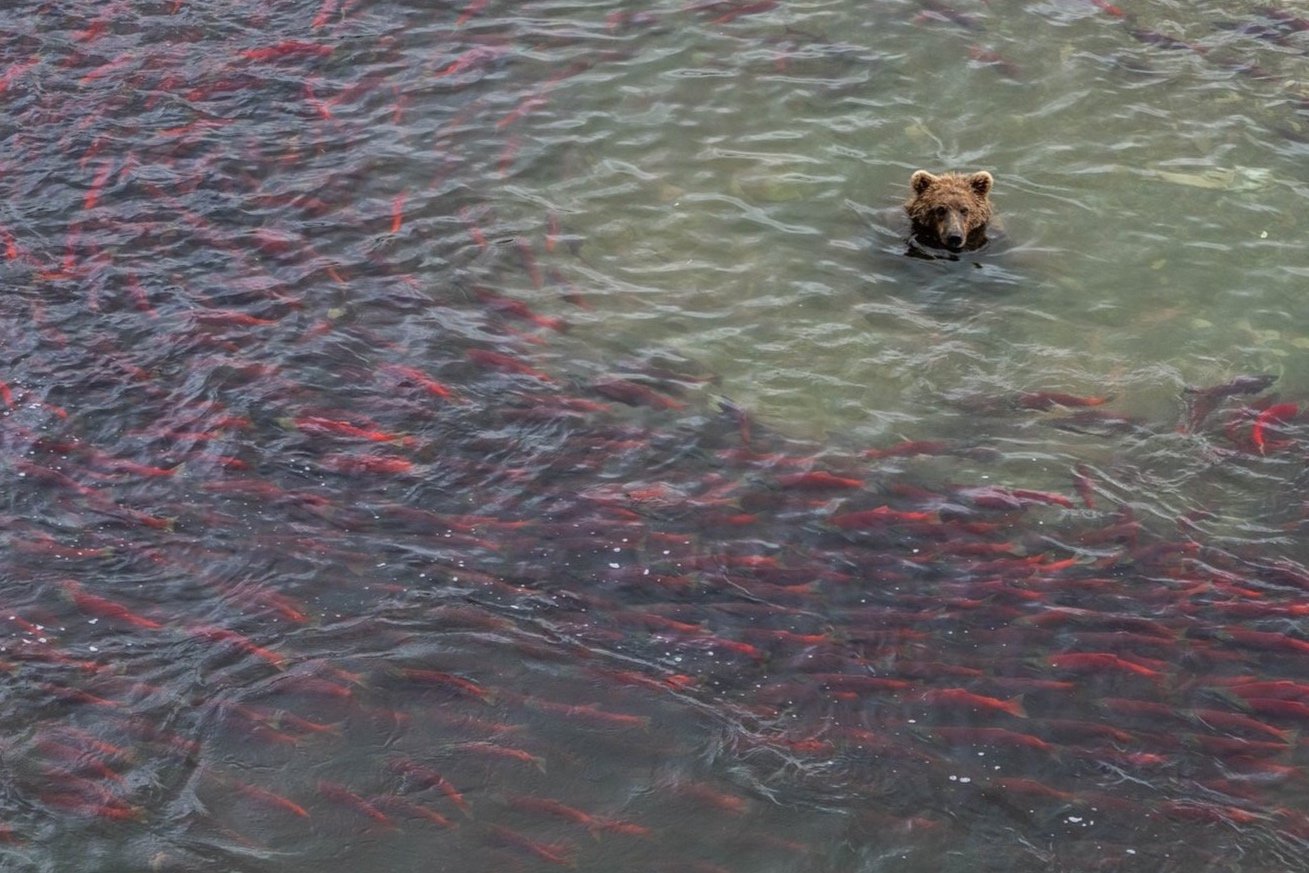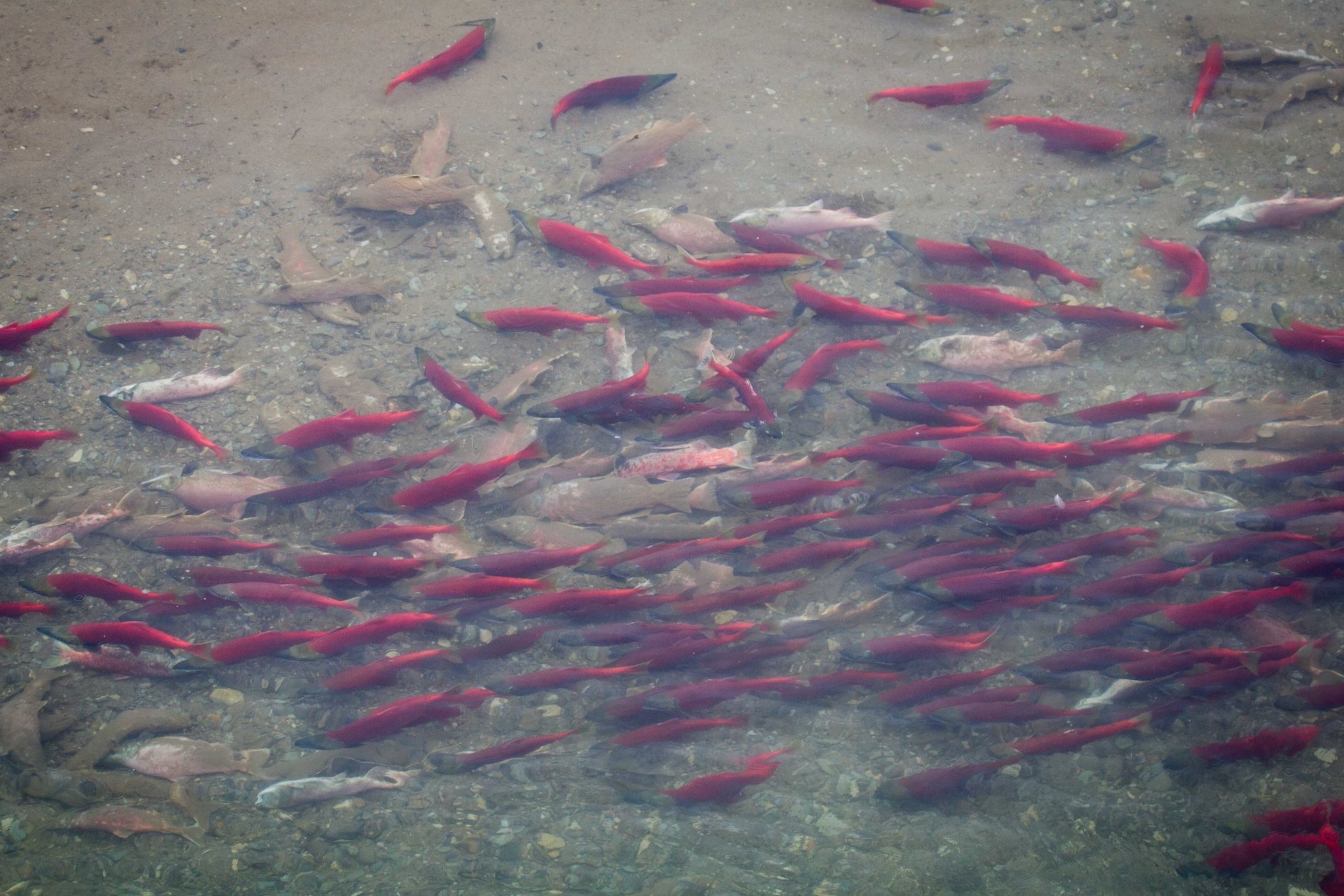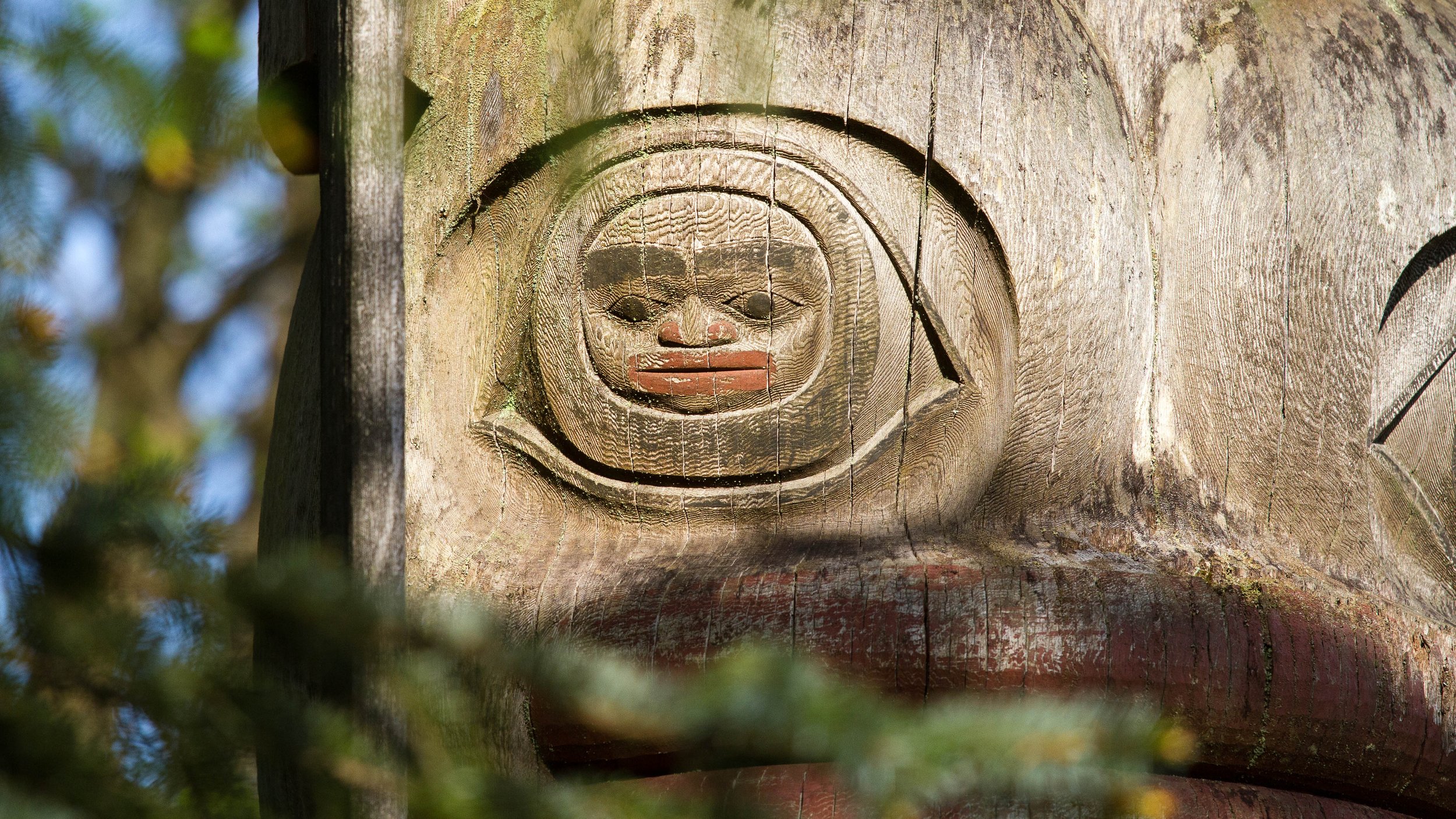Salmnesia: A Film
What is our approach? How will we be able to tell this story effectively?
Our project’s moral compass bearing, our true north, points to honesty and compassion.
In Southeast Alaska, there’s a small creek where big magic happens. For four to five weeks every year, two species of wild salmon return to the place where they were born, on a mission to reproduce. They come by the thousands. Tens of thousands. Their numbers so prolific that the creek turns reddish-purple with the mass of their bodies. The neighboring wildlife are all aware of this. They’ve grown to expect it, every single summer. Bears, otters, marten and mink, eagles, ravens, seals, sea lions. Killer whales cruise the nearshore waters on the lookout for foraging seals. It’s straight out of National Geographic. Not far away, communities of subsistence fishermen carry on the tradition of the annual harvest of enough salmon to feed a household for an entire year, paying reverential respect for their sacrifice, and celebrating the gifts that their world provides. This is a practice that has occurred locally for thousands of years, and it continues to this day. Further afield, a fleet of commercial fishing boats catch the “wild Alaskan salmon” that reach grocery stores, restaurants, and fish markets across the country. Their hard work, both physically and mentally demanding, provides enough of an income to keep a roof over their families’ heads and food on the table. It is an ecosystem that is relatively intact, with human cultural traditions and sustainable industries participating in it.
When the salmon reproduce, a process called “spawning,” it is their life’s final act. They’ve evolved to return to their spawning grounds for one purpose: to give their lives for their future offspring. The next generation. The future of their species. And as long as their spawning event is successful, the cycle continues, year after year. Like a heart beat.
When female salmon lay their eggs, or when male salmon fertilize eggs that have been laid, their bodies shut down, quickly turning off their light so that more lights will be born. And just imagine the scene. Thousands upon thousands of big, wild, organic, protein-rich salmon bodies flushing downstream, piling up onshore along the creek’s banks. Bears, mink and marten, and birds haul these carcasses off into the adjacent woods to enjoy a meal by themselves, depositing countless salmon bodies throughout the forest, thus enriching the soil and supporting the forest’s health in the dependable, annual process. More spawned-out salmon flush downstream to more animals laying in wait, including crab, who count on this cyclical bounty. Nothing goes to waste. Every single salmon, either caught while alive or feasted on after death, is consumed by a rich, bio-dense community. The place is truly alive, and it functions like clockwork. Its heart continues to beat year after year with the arrival of the salmon.
But the thing is, this creek is so small, so benign, that it isn’t even labeled on Google maps. Most people, Alaskans included, have never even heard of it. Want to know why? Because it’s one of more than five thousand creeks and streams identified by Alaskan biologists that enjoy this prolific annual process, year after year. Nearly the entire coastline, from Ketchikan to Kodiak to the Kuskokwim River and beyond, lives with salmon as its beating heart: Alaska is alive with the rhythm of salmon runs.
What’s more, this same heartbeat used to extend from the Bering Sea all the way to San Francisco Bay, not long ago. When my grandmother was born in 1911, there were still wild, productive salmon streams throughout Puget Sound, the Oregon coast, and the California coast, complete with the corresponding massive aggregations of diverse wildlife, from bears to seals to crabs to people. In the late 1800s, there were dozens of wild salmon canneries along the rivers that drain into San Francisco Bay, and in Puget Sound, there were even more. Today, those canneries are relics of days gone by. Historical landmarks, artifacts, plaques, and boutique shoppes standing where salmon once spawned. Where did all of that go, and why did it go away so quickly?
These two questions are central to the purpose of our film. What happened to West Coast salmon, and why do they still survive in northern British Columbia and Alaska?
The question of where all of those millions of salmon went, and so quickly, brings to mind the concept of “generational amnesia.” Peter Kahn, a psychology professor with the University of Washington describes the phenomenon in this way: each new generation that inherits this planet perceives the environment into which it’s born, no matter how developed, urbanized, or lacking in biodensity or biodiversity, as “the norm.” And it’s a cascading effect. It becomes difficult to truly see just how far we’ve come from what once was with each subsequent generation, because our points of reference are only those that surround us. A West Coast that enjoys a small fraction of its historical salmon populations, most of which are hatchery-reared, has become the present “norm.”
But thankfully, we still have reference points and historical records. Alaska and parts of northern British Columbia and the Yukon Territory, with their prolific salmon runs up and down their coasts and rivers, help serve as a reference, or ironically as a “True North” compass bearing, helping us remember what coastal shorelines and ocean-bound streams in the North Pacific can and should look like. And our historical records, ranging from as diverse of sources as coastal indigenous art and oral narrative, 19th and 20th century literary legends like John Steinbeck and Jack London, and incredible scientific processes including stable isotope analysis in soil samples and habitat extrapolation, help us understand that the enormous annual gift of millions of salmon weren’t always a uniquely Alaskan and northern British Columbian phenomenon. That process occurred along the coast and into the mountains, ranging as far south as Central California and as deep into the mountains as Idaho’s Snake River.
One of several contemporary challenges that we face, specifically associated with salmon and other keystone fish species upon which they (and innumerable other wildlife) depend, is the concept of “shifting baselines.” That concept is loosely defined as a type of change to how a system is measured, usually against previous and/or relatively recent reference points, which themselves may (and often) represent significant changes from an even earlier state of the system. It is in this way that many local, state, provincial, and federal agencies report on modern salmon populations, indicating slight increases or decreases from one year to the next, rather than acknowledging the reality that those numbers represent mere fractions of what they were less than one hundred years ago. In doing so, we celebrate “the return” of salmon, while the ecosystem as a whole continues to suffer in full view.
A man I once knew years ago wrote a book in 2001, entitled The Great Remembering. In it, he points out that then, in the year 2001, the average American could identify more than 1,000 corporations by their logo alone, but could not identify three species of tree in their own community. It is precisely this phenomenon, the contemporary ways in which we relate to our current surrounding environmental conditions, that has led to the process of generational amnesia. Not knowing what we’ve forgotten. And if we don’t remember what we’ve forgotten, it is impossible to know where we are going.
Which is the crux of this film. It is no secret that millions of Americans, Canadians, and countless others are looking around at the world presently in a state of perplexity. A general unease infiltrates many people’s minds, whether they talk about it openly or not. A significant and nearly ubiquitous elephant in the room. Many people daydream about where they would go if they had the money to do so: somewhere bountiful in nature, with access to clean water and wild forests, where food and resources were at one’s front door, rather than dependent upon a fragile global supply chain. In times of uncertainty, there seems no better place on the planet to live than a region abundant in clean water and rich beyond measure in one of earth’s healthiest foods: wild salmon. Wouldn’t that be a dream come true?
In a transitionary time replete with complex uncertainties, it is wise to look out at the horizon and be simultaneously realistic and idealistic. What is the state of our world? What is the state of the living planet upon which we depend? And assess it honestly. The challenge, and the one that we must take on, is to have the courage to not succumb to fatalism. To not succumb to cynicism. To be both realistic and idealistic, and envision on the horizon where we want to go. On what sort of planet we want to give ourselves, to give our children and their children. And then make it happen. But we can only do so if we know what we’re capable of, what our planet is capable of. It is only possible if we know where we came from and how we got here. From that position, we can march into our shared future with a sense of hope, determination, and courage.
This isn’t a project that focuses on one salmon river, one species, one piece of legislation. It’s bigger that. It is a story about Us, as people up and down the West Coast, across five states, one province and one territory, two countries, and more than a dozen Native and First Nations. It is a story that transcends individual communities and individual species. It is a story of coming together.



